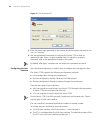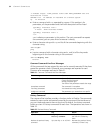
28 CHAPTER 1: SYSTEM ACCESS
Command Line
Interface
The Switch 7750 provides a series of configuration commands and command line
interfaces for configuring and managing the Switch 7750. The command line
interface has the following features.
■ Local configuration through the console port.
■ Local or remote configuration through Telnet.
■ Remote configuration through a dial-up Modem to log in to the Switch 7750.
■ Hierarchy command protection to prevent unauthorized users from accessing
the switch.
■ Access to online Help by entering ?.
■ Network test commands, such as Tracert and Ping, for rapid troubleshooting of
the network.
■ Detailed debugging information to help with network troubleshooting.
■ Ability to log in and manage other Switch 7750s directly, using the telnet
command.
■ FTP service for the users to upload and download files.
■ Ability to view previously executed commands.
■ The command line interpreter that searches for a target not fully matching the
keywords. You can enter the whole keyword or part of it, as long as it is unique
and not ambiguous.
Configuring a Command Line Interface is described in the following sections:
■ Command Line View
■ Features and Functions of the Command Line
Command Line View The Switch 7750 provides hierarchy protection for the command lines to prevent
unauthorized users from accessing the switch illegally.
There are four levels of commands:
■ Visit level — involves commands for network diagnosis tools (such as ping and
tracert), command of the switch between different language environments
of user interface (language-mode) and the
telnet command. Saving the
configuration file is not allowed on this level of commands.
■ Monitoring level — includes the display command and the debugging
command for system maintenance, service fault diagnosis, and so on. Saving
the configuration file is not allowed on this level of commands.
■ Configuration level — provides service configuration command, such as the
routing command and commands on each network layer that are used to
provide direct network service to the user.
■ Management level — influences the basic operation of the system and the
system support module which plays a support role for service. Commands at
this level involve file system commands, FTP commands, TFTP commands,
XModem downloading commands, user management commands, and level
setting commands.


















